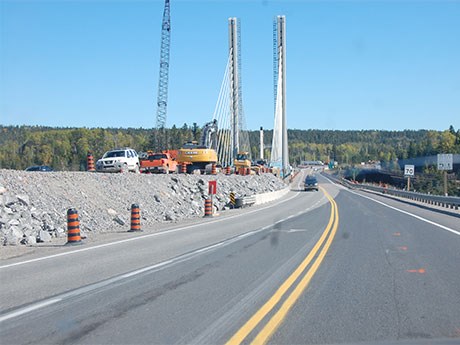The cause behind the broken bolts that closed the Nipigon Bridge to cross-Canada traffic last January is being attributed to an “overloading” of those connections, rather than any flaws in the bolts themselves.
The Ontario government finally released the results of the analysis behind the bridge’s malfunction at a press conference at the bridge site on Sept. 22, attended by Transportation Minister Steven Del Duca and Northern Development Minister and Thunder Bay-Superior North MPP Michael Gravelle.
The $106-million bridge is located on the north shore of Lake Superior, about an hour’s drive east of Thunder Bay.
The 252-metre cable-stayed bridge failed on January 10, two months after opening, due to an issue with a tie-down connection on the span’s northwest corner.
It caused the eastern section of the bridge to rise about two feet and resulted in a severe backlog of traffic on the Trans-Canada Highway.
The cause of the malfunction was boiled
down to three main factors:
- the design of the shoe plate and
its flexibility
- a lack of rotation in the bearing
that was constructed
- improperly tightened bolts
attaching the girder to the shoe plate.
Wind and cold temperatures have been ruled out.
With repair work still ongoing, the bridge bill is expected to come in somewhere between $8 million and $12 million.
Any analysis of the bridge’s malfunction was done both internally by Ministry of Transportation bridge engineers and outside labs.
Two research testing facilities – the University of Western Ontario’s Surface Science lab and the National Research Council Canada – each received 14 broken bolts and 10 intact bolts from the bridge to test.
Each lab worked independently and shared their results with the ministry last summer.
Two separate engineering analysis by ministry bridge engineers and an outside engineering firm looking at the cause of the malfunction reached the same conclusion.
A new design fix has been developed to address these issues, the province said, to ensure the bridge “functions safely for road users throughout its intended useful life.”
The design will be reviewed by Associated Engineering, an Ontario firm, along with ministry engineers and will be applied to the bridge’s south half where repair work continues.
Since the bridge span is the only highway link connecting eastern and western Canada, the province said it is further embarking on a formal route planning study and environmental assessment for an emergency detour route. It is expected to take 18 months to complete.
In a joint statement, Del Duca and Gravelle said that the “government has full confidence that the retrofit, once complete, will ensure that the bridge is safe for all users, this detour route would provide an alternate option for local residents and businesses in an emergency.
“The safety of the travelling public is of paramount importance to our government, and we appreciate the ongoing patience and understanding of the people who use and depend on this bridge."




